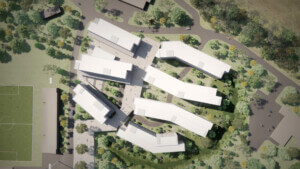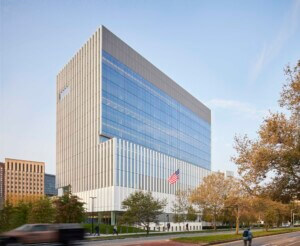An ongoing fight over a storied Manhattan landmark proves that indeed, size does matter.
Fosun International, the Shanghai-based owner of lower Manhattan’s 28 Liberty Street (formerly One Chase Manhattan Plaza), has commissioned SOM to revamp their own classic International Style building and 2.5-acre plaza design. Among its planned changes to the site, Fosun received Landmarks Preservation Commission (LPC) approval to build three glass cubes on the landmarked plaza that will serve as entrances to below-ground retail.
Although the commission approved the scheme, implementing changes at 28 Liberty requires an additional, and contentious, next step.
Fosun is seeking a modification of 28 Liberty’s deed restriction that would allow the cubes to rise 11 to 17 feet above the highest points of the plaza, heights that far exceed the deed restriction’s stipulation that structures rise no more than six feet above the highest point on the plaza.
Both the International Style building and plaza were designated a New York City Landmark in 2009. SOM is updating the tower’s office space and plaza and reintroducing original details lost in prior renovations while transforming approximately 290,000 square feet (four floors) of basement space into retail. (AN first covered the design proposal, and ensuing controversy, in July.)
Renovations will add accessible entrances and restore tree wells on the south plaza. Along Pine Street, the project will conserve on-site art, remove air intakes, and perhaps most crucially to the design, reinstate the parapet that encircles the space, particularly a corner at Liberty and Nassau Streets that renovations have compromised over time.
The developers maintain that the glass cubes, or pavilions, are a key part of the renovations. Fosun argues that the three pavilions will improve handicap accessibility to the stepped plaza as well as protect shoppers entering and exiting the retail spaces from inclement weather. The pavilions, along with glass storefronts along Liberty and Williams Streets, are intended to activate street frontage and encourage more fluidity between indoor and outdoor, below-grade and street-level spaces of the plaza, sidewalk, and tower.
Although some later modifications imitate original conditions, all of the plaza’s elements are non-original aside from the Isamu Noguchi sunken garden. (The black-and-white Jean Dubuffet sculpture, installed 1971, was not included in the landmark designation.) The space is not a privately-owned public space (POPS), but remains open to the public nonetheless.
Some Community Board 1 (CB1) members say the design and the deed restriction, although technically unrelated, cannot be considered independently from each other. They point to the scale of the pavilions as proof: According to plans filed with the Department of Buildings, the three proposed pavilions, pictured in plan above, are a 17-foot-tall, 46-foot-long, 1,473-square-foot cube at the corner of Nassau and Liberty Streets; another 16-foot-tall, 43-foot-long, 1,132-square-foot cube facing Pine Street; and a third 11-foot-tall, 18-foot-long, and 418-square-foot at Cedar Street (which a CB1 joint committee ultimately rejected at a July 2016 meeting).
A site tour with the architects scheduled September 23 was canceled because key stakeholders from Fosun and SOM were not able to attend. Instead, CB1 board members led a peer-to-peer tour, showing their colleagues the scale of the pavilions and their placement on the plaza.
The cubes’ size is not the only point of contention. Some residents think the architects’ renderings suggest the cubes are being rendered too transparently (a common offense in renderings), and that the built structures will impede sightlines on the plaza, especially to the Dubuffet and Noguchi pieces.
“Depending on light angles and angles, a glass cube can be quite reflective. At most angles, glass cubes are pretty transparent, but they are not like a window, they’re totally going to interrupt the view,” said Michael Ludvik, glass engineer and founding principal of M. Ludvik Engineering.
SOM’s glass pavilions have been compared to the Apple Cube, which is not entirely accurate, Ludvik said. The Apple Cube is not made of anti-reflective glass, so when viewed from an angle, it can look almost opaque. To make the proposed pavilions as transparent as possible, he suggested using the thinnest and clearest glass available, along with appropriate fins to minimize impact on clarity.
SOM could not be reached for comment on the glass choice, but a spokesperson for the developer explained that they are not far enough along in the process to have made a materials choice.
For one CB1 board member, design and deed are unequivocally separate. “The current owners are not the omnivorous developer creatures we’d expect,” said Bruce Ehrmann, co-chair of CB1’s Landmarks Committee. “They are trying to steward the plaza. They followed our original CB1 resolution, and they followed the instructions from the LPC. This issue is about a six-foot height cap,” not the design, Ehrmann said. An architecture enthusiast, Ehrmann maintained that “the first proposal changed the whole nature of the Modernist platform. It’s important to the plaza that the parapet is restored.”
Alice Blank, an architect and resident who also serves on CB1’s board, asks why the design can’t be done differently, without the large pavilions that trigger the deed restriction modification: “I need to know, have all alternatives been considered before pavilions were added on top of the plaza? I need to know why the existing street level entrances to the underground cannot be adapted.”
She noted that the pavilions didn’t appear in earlier iterations of the design, pointing to SOM’s May 2015 LPC presentation that showed capped entrances to the retail space and only one pavilion, a stair enclosure at Cedar Street, pictured above. While she doesn’t endorse the first design per se, she sees it as an example of how alternatives could be crafted to improve access without adding glass cubes.
At the August 2015 meeting, commissioners raised questions about the height and transparency of the cubes before granting approval. One LPC commissioner, noting that the cubes were two and three times taller than an average human, asked what was driving the height of the cubes. “The sidewalk is incredibly varied around the site,” said Roger Duffy, design partner at SOM. He explained to the commission that the taller-than-human height is required to prevent mischief and liability: “If [a person] climbed on top of the parapet, they couldn’t climb on top of the pavilion,” Duffy said.
The community board, though, didn’t approve the same plans that the LPC did. The LPC’s August decision came after the community board’s review of SOM and Fosun’s original plans. “We are being asked to modify a deed on a proposal the full Board never saw or approved,” said Blank.
In July, a spokesperson for the developer issued a statement on the deed restriction modification to assuage concerns about the modification: “CB1 is voting on a MINOR MODIFICATION which would ONLY PERMIT THE CONSTRUCTION OF THE GLASS PAVILLIONS [sic] AS APPROVED BY THE LANDMARKS AND PRESERVATION COMMISSION [sic], AND NO OTHER CHANGES. THERE IS NO CREATION OF ADDITIONAL RETAIL SPACE, AND NO CHANGE OF USE.”
Blank questioned the impact of the changes and the legacy they could set. “Development is important, but [a] violation of commitments to preserve open space for the public in perpetuity ought to be reviewed with extraordinary care in light of the compromise of the public interest. What would be next—Seagrams, Lever House?”
In a statement, the preservation advocacy group Historic Districts Council (HDC) echoed Blank’s question in their indictment of the proposed deed restriction modification:
“The sheer existence of such a restriction reveals the great foresight and care which went into the planning of this architecture to prevent it from being marred from future, insensitive fads, most relevantly the corporate ‘Apple Cube.’ More broadly, the proliferation of recent deed changes which disadvantage the public to serve private entities is deplorable. Any changes should be weighed in the context of the long term: Is it wise to permanently alter an individual landmark for the current owner? Do these proposed spaces hold any longitudinal, classical value?”
Both the HDC’s and Blank’s concerns mirror public outcry over the recent Rivington House scandal, in which the city lifted a deed restriction that mandated the property be managed as a healthcare nonprofit, a move that allowed the owner to profit handsomely from the sale of the property. In response, Mayor de Blasio has announced a series of reforms to the deed modification process that could impact the dealings at 28 Liberty in the near future. Faulting “a process that has failed to protect and preserve significant community assets, like Rivington House,” Councilmember Margaret Chin, whose district includes 28 Liberty, along with speaker Melissa Mark-Viverito, Councilmember Ben Kallos, and Manhattan borough president Gale Brewer, favor a process that would make deed restriction changes subject to a ULURP.
Although Fosun is not seeking to lift the deed restrictions, it has paid James Capalino, the same lobbyist involved in the Rivington House deal, $120,000 since January 2015 to push the city’s Department of Citywide Administrative Services (DCAS) for deed modifications at 28 Liberty, DNAinfo reports.
Judgment day for the plaza is near. The board is voting tomorrow on the modification of the deed restriction it tabled in July, thus confirming the fate of the design and the deed restriction. Although the board’s decision is purely advisory, a vote to modify could give Fosun leverage in future discussions with DCAS to modify the deed restriction.










